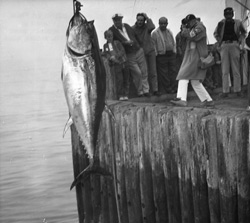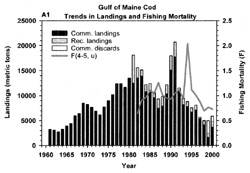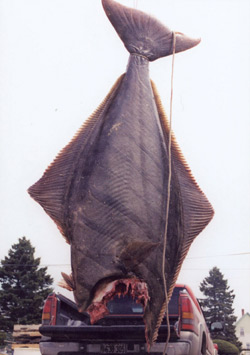
Among the “What’s going on out there?” questions includes those about tuna. Tuna have not only been smaller, in the Gulf of Maine they haven’t “been” at all. |
Dr. Steven Berkeley is a research biologist at the Long Marine Laboratory at the University of California, Santa Cruz. He’s excited about Conover’s discoveries, but cautions a knee-jerk reaction that everything bad that’s happening in the ocean is caused by evolution.
“There are so many variables,” Berkeley said, “It’s not always easy to know if there’s a genetic basis, even if it was done with silversides in the laboratory. There is a possibility that this could certainly happen in the ocean, but again, there are so many variables when you consider a stock that is fished heavily.”
Berkeley insists that the big key to this is how heavily a stock is being fished.
“To say that fishing is having a genetic effect, you have to have a situation where fishing is pretty much the most important source of mortality,” Berkeley said. “If it were a relatively small source of mortality, it would be pretty hard to make the case that fishing could change the genetics within any time frame that we could measure. The problem, as I see it, is that the fishing pressure can and has exceeded the ability of many species to reproduce.”
Rapid Evolution
Rapid Evolution is quickly becoming the new catch phrase among marine scientists, but Conover, Berkeley and other scientists, like Dr. Hans Dam, a biological oceanographer in the Department of Marine Sciences at the University of Connecticut, , will tell you that rapid evolution is anything but new.
“When you say rapid evolution, the question is, ‘What’s rapid?’” explained Dam. “Typically people think that evolution is a thing that happens very, very slowly, over hundreds and millions of years, but it can also happen quickly. Evolution is measured in generations, not years. It’s what happens from generation to generation that we’re looking at. Rapid evolution simply means that it’s happening before our eyes, but it’s still happening over generations of the species. For humans, it might take 1,000 years to see the evolutionary changes that Dave [Conover] can see in silversides in four years. The metrics is different for humans and other species. That’s what you have to keep in mind. Rapid evolution is the number of generations. And while it may take a long time for humans, it can be a relatively short time, rapid, for many other species, like fish.”

The increase in landings parallels the government supported, management directed industrial harvesting model. The model continued as the curve dropped off. This data is well known by now in the ground fish fishery. What it all means is not. |
Conover says that we’re already seeing evidence of rapid evolution in the marine commercial stocks like cod.
“Cod is maturing at much smaller sizes,” Conover said. “Sizes, that just a few decades ago, were unheard of. In the fishery, the goal is not only to be able to harvest fish…but to do it in perpetuity. Here the mortality has a partial effect, but the survivors tend to be those with characteristic that make them less susceptible to being caught. One of those characteristics is having a smaller size or growing slower.”
“This is an interesting issue that hasn’t been on the radar screens of many people in fishery management,” Berkeley said, “and it needs to be. That’s why this research that Conover is doing is potentially so important, if it can be applied to the ocean. Because, selection from the fishery is size and age related. In general, the tendency is for the bigger fish to be removed quickly. We’ve created a selection process that’s exactly opposite from a natural process, in general. That’s the biggest problem. We’re imposing situations that are exactly opposite from what these fish have evolved from, where the highest mortality is generally concentrated on the smaller, younger fish. Then, all of a sudden, the biggest predator out there, man, is selecting exactly the other fish, the big, long lived, older fish.”
Berkeley says it’s a selection process that may or may not be conducive to the evolution of bigger and bigger fish.
“Common sense would tell you what we’re doing is backward animal husbandry,” Berkeley said. “What we’ll end up with, eventually, is smaller and smaller fish or the accidental eradication of the species. We’re rolling the weak and the infirm back into a gene pool that a more natural process would have taken them out of. It’s something that fishery management should be thinking about.”
David Libby, a scientist with Maine’s Department of Marine Fisheries (DMR), hasn’t heard any discussions on the management level about rapid evolution and its long-term effect on the Gulf of Maine fishery. Libby, who specializes in Atlantic herring, Maine landings, and BRM (Binary Relationship Modeling) database, agrees with Berkeley, that the first step in the research would be quantifying the data.
“I think you could affect stocks of fish this way,” Libby said. “It’s done in animal husbandry and selective breeding. It’s been around forever. But you’re talking about wild stocks in the ocean and there hasn’t been much thought about how we’re affecting the evolution of fisheries through fishing. I’m not saying it’s not an interesting idea. But, we’d need some more science, the best possible science, on it before it could ever start to influence the management of the fisheries. And, right now I’m just trying to keep guys on the water making a living.”
But Dam says that understanding the rapid evolution of fish is what will keep the ocean food chain a food chain.
“In terms of the fisheries, clearly, we as human beings are doing a huge, uncontrolled experiment through fishing,” Dam said. “Dave [Conover] has proven some things with the Atlantic silversides, but we’re fishing all kinds of fish out there and we’re over-fishing many species. The fishermen are doing the selecting. If we fish by size, we are selecting for fast growing genes. When you do that, the species tend to mature when they are smaller, but they also tend to produce fewer eggs. So, like it or not, we have indeed started a huge uncontrolled experiment by fishing at the level we’re fishing at. Without understanding the evolutionary history of populations, we will be hard-pressed to come up with effective management plans for living marine resources.”

The huge fish was more common in the past, but was not the norm. Occasionally they would be caught and the occasion recorded. |
Rapid Fishery Evolution In The 1950s
In a 2003 Wrack Lines Magazine article about evolution, Dam points to some of the first research done on the subject by fisheries biologist W.E. Ricker. According to Dam, in the 50’s, Ricker documented a 30% decrease in the mean size of pink salmon caught off British Columbia, Canada.
“The larger sized two–year-old salmon, returning to their spawning ground, were disproportionately caught by fishermen in the gill nets,” Dam said, “Ricker found that relatively few of the larger salmon ever made it to spawn. In contrast, the slower-growing and thus smaller salmon passed through the nets and produced offspring. Ricker’s research showed that over the years, the proportion of slow-growing individuals increased in the population, leading to a decrease in mean size of the fish caught in the gill nets.”
“In the fisheries, we don’t try to eradicate,” Conover said. “And the life cycles of the organisms that we’re dealing with are relatively longer than pests and bacteria. So, it’s taken longer for us to realize that these same principals of evolution apply, that rapid evolution is occurring.”
Conover’s Experiment
“The reason we’ve used silversides is because they have a one-year life cycle,” Conover said. “We have six different populations. For 10 years we’ve been harvesting the different populations for maximum size, minimum size, or random size. Now, we have two tanks full of mega-sized silversides, two tanks full of mini-silversides and two tanks full of original sized silversides. The next step is to start adjusting the populations for random sample, all of which is to see how long it will take, or if it’s even possible to revert back to their original characteristics. In other words, we’re looking at the permanence of the evolutionary changes that we created. This work has been an eye opener and will probably continue to be an eye opener for a lot of people.”
How Does This Apply?
Conover’s work may explain why some stocks, like the Atlantic cod fishery, aren’t bouncing back the way they should.
“That’s not supposed to happen, according to accepted theory,” Conover says. The remaining fish “are supposed to find food, create a breeding base and have lots of offspring.”
“I’ve had a surprising number of recreational fishermen contact me,” Conover said. “Lakes that have a minimum size limit, but no maximum size limit could see a shrinking in the size of their stock. [Of course, the evolutionary process is slowed because most lakes are stocked annually with new fish to the gene pool.] I’ve also been talking to people about marine protected areas. They at least protect a fragment of the fish population. The lobster fishery in Maine has initiated some rules [minimum and maximum size limits as well as protection of egg breading females]. Those rules were originally designed to protect the breeding stock, but might also be creating some evolutionary changes in the species. That would be an interesting area to look into.”
Conover is one of only a few scientists in the world doing this sort of research, and the only scientist in the US. Perhaps his work will open the door to the evolutionary study of other species. He choose silversides because of their quick reproduction rate and relatively short life span. What’s needed now is a group of scientist willing to do the same sort of study on longer-lived species.
|





